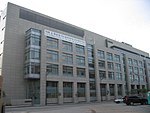Wattis Institute for Contemporary Arts
1998 establishments in CaliforniaArt galleries established in 1998Art museums and galleries in San FranciscoArts centers in CaliforniaCalifornia College of the Arts ... and 2 more
Contemporary art galleries in the United StatesPotrero Hill, San Francisco

Established in 1998, the Wattis Institute for Contemporary Arts is a contemporary art center in San Francisco, California, US, and part of the California College of the Arts. It holds exhibitions, lectures, and symposia, releases publications, and runs a residency program, Wattis.
Excerpt from the Wikipedia article Wattis Institute for Contemporary Arts (License: CC BY-SA 3.0, Authors, Images).Wattis Institute for Contemporary Arts
Carolina Street, San Francisco
Geographical coordinates (GPS) Address Website Nearby Places Show on map
Geographical coordinates (GPS)
| Latitude | Longitude |
|---|---|
| N 37.76716 ° | E -122.400046 ° |
Address
California College of the Arts (CCA)
Carolina Street
90103 San Francisco
California, United States
Open on Google Maps





